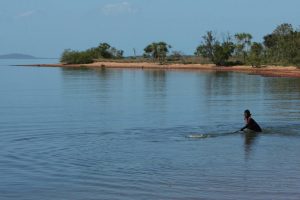Culture and Environment
Yolŋu worldview sees every species of plant, animal, fish, bird or any place or person as belonging to one of the two balancing halves of the world (moieties); Yirritja or Dhuwa. The sacred art of this region details the spiritual forces behind the ongoing Creation and continuing identity of the fresh and saltwater country of the Miwatj region – a very special part of Australia.
identity of the fresh and saltwater country of the Miwatj region – a very special part of Australia.
The coastline and hinterland are largely unspoilt and still managed by the traditional owners, the Yolŋu. The ecosystems of both the land
and sea are pristine and provide abundant food subject to the season including yams, fruits, fish, kangaroo, wallaby, turtles and their eggs, dugong, emu, crayfish, oysters, mussels, tortoise, stingray, honey and more.
The foods and the land that supports them are a seamless part of the wholistic Creation celebrated and maintained by almost continuous ceremonial activity. There is a constant interplay between the Law, the Land, the art of the Yolŋu, their ceremony and lifestyle.
The Artists
Yolŋu people are all capable and entitled to express their sacred identity through art. The artists who work through the Centre are men and women of all ages. The art and craft of Buku-Larrŋgay Mulka is drawn from Yirrkala and the approximately 25 homeland centres within a radius of 200km. The major clans of the Miwatj are; Gumatj, Rirratjingu, Djapu, Manggalili, Marrakulu, Madarrpa, Gälpu, Dhalwangu, Dätiwuy, Ngaymil, Djarrwark, Djambarrpuyngu, Wangurri, Warramiri, Dhudi-Djapu, Gupapuyngu and Munyuku.